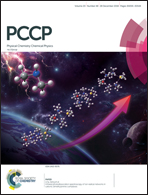Relations between the aromaticity and magnetic dipole transitions in the electronic spectra of hetero[8]circulenes†
Abstract
Magnetically induced current densities have been calculated at the second-order Møller–Plesset perturbation theory (MP2) level for seven hetero[8]circulenes and their dicationic and dianionic forms. Calculations of the magnetic dipole transition moments have also been carried out at the algebraic diagrammatic construction (ADC(2)) and the second-order approximate coupled-cluster (CC2) levels. The calculations show that the degree of aromaticity and the size of the magnetic dipole transition moment of the lowest magnetic-dipole allowed excited state are related. We show that neutral hetero[8]circulenes are weakly antiaromatic when the first excited state with a large magnetic dipole transition moment of 10–16 a.u. lies at high energies (∼2.8–3.5 eV). For the dications, this transition often lies at much lower energies. Hetero[8]circulene dications with large magnetic dipole transition moments are strongly antiaromatic. The lowest excited states of the hetero[8]circulene dianions have very small magnetic dipole transition moments implying that they are aromatic.
![Graphical abstract: Relations between the aromaticity and magnetic dipole transitions in the electronic spectra of hetero[8]circulenes](/en/Image/Get?imageInfo.ImageType=GA&imageInfo.ImageIdentifier.ManuscriptID=C8CP05694C&imageInfo.ImageIdentifier.Year=2018)


 Please wait while we load your content...
Please wait while we load your content...